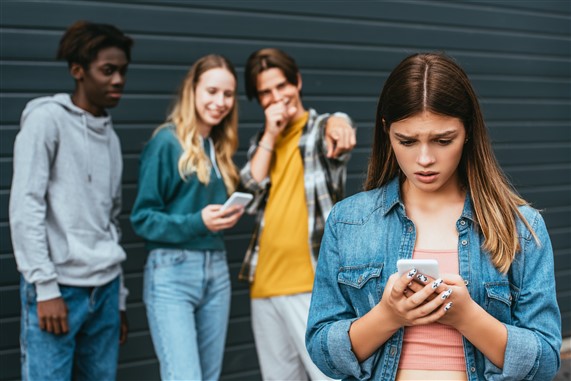Why are schools banning cell phones? Is it because they are disruptive to the learning process? Or because students pay more attention to their phones than to their teachers? Or maybe they are just annoying distractions. Increasingly, schools cite student safety as a reason to ban phones during school hours.
“Banning students’ access to phones at school means kids would not receive notifications for at least that seven-hour period and have fewer hours in the day to use apps,” the study’s authors wrote in an overview of the study published by The Conversation, a nonprofit publication written by academic experts.
Picture an ordinary day in a typical classroom. A teenage girl is holding her phone discreetly under her desk, absorbed in looking at the screen. When the teacher calls on her and gets no response, she walks over and grabs the phone out of the girl’s hands. The girl burst into tears, reaching out to get her phone back, sobbing uncontrollably.
It’s normal for kids to get mad if a parent or teacher takes something away from them. But why would losing access to that phone cause the girl to panic? Researchers are finding that some teens are becoming addicted to phones and social media. We think of addiction in relation to drugs and alcohol, but addiction to anything is a mental illness that is difficult to control.
There is a relationship between addictive behavior and suicidal ideation, regardless of what a person is actually addicted to.
Addictive Phone Use, Not Just Time Spent, Is Key
Recent longitudinal studies involving over 4,000–4,300 children aged 9–10 tracked over several years reveal that addictive use—characterized by compulsion, inability to stop, craving, or distress when away from the device—is strongly associated with suicidal ideation and behaviors. Those with high or increasing addictive use had 2–3× higher rates of suicidal thoughts and behaviors compared to peers with low-risk use
Importantly, total screen time alone had no significant link to suicide risk—highlighting that the behavioral patterns driving addiction are what matter most
A large 2023 study of nearly 19,000 college students used the Mobile Phone Addiction Tendency Scale (MPATS). Findings included:
- ~30% met criteria for mobile phone addiction.
- Those classified as such had 70% higher odds of suicidal ideation and 48% higher odds of past suicide attempts, even after adjusting for depression, sleep, and social support
This reinforces that for youths up to age 25, addiction to phones—not mere use—elevates suicide risk.
How and Why It Happens
- Addiction-Like Effects: Similar to substance addiction, withdrawal-like symptoms (withdrawal, craving, tolerance) can disrupt mood and coping.
- Sleep & Mood Impacts: Compulsive device use often disturbs sleep and intensifies anxiety or depression, each independently increasing suicide risk
- Social Isolation & Cyberbullying: Heavy online use can worsen loneliness, reduce face-to-face interaction, and amplify exposure to cyberbullying—all tied closely to suicidal ideation.
- Brain and Emotional Dysregulation: Emerging evidence hints at phone overuse altering neural circuits tied to emotion regulation, similar to patterns seen in substance addiction.
- Bidirectional Influence: Real-time smartphone screen usage (captured via screenshots every ~5s) tracked in adults showed that increased use often preceded rises in suicidal risk within 3 hours, and suicidal thoughts also predicted spikes in screen time—suggesting a cyclical dynamic
Tips for Parents and Educators
- Watch for addiction signs, not just screen time:
- Intense cravings, irritability when separated from device, interference with sleep or tasks.
- Prioritize emotional/cognitive health:
- Assess for anxiety, depression, and sleep problems in youth with addictive phone habits.
- Encourage healthy boundaries:
- Promote “phone-free” zones (bedrooms, meals, outings) and offline activities.
- Teach coping strategies:
- Support emotional regulation skills; consider therapeutic approaches if addictive patterns emerge.
- Support safe digital environments:
- Proactively address cyberbullying, curate social media content, build supportive online/offline communities.
Conclusion
Experts recommend: “Don’t just focus on time — focus on behavior. It’s not about how many hours your child spends on a device, but whether their use is interfering with sleep, school, relationships, or mood.”
Overall, evidence suggests that banning phones in schools may not be an easy solution for students’ mental health problems, poor academic performance, or cyberbullying. Cell phones provide a sense of security for parents who want their kids to be able to contact them in case of emergencies. Students who use their phones responsibly while in school may benefit from having access to them.
However, for students who see their phones as their only way to navigate the world and are addicted to social media and instant communication with others, banning cell phones in school may lead to suicidal behavior. Those addictions will not be cured by taking away phones. They should be treated by mental health professionals.
When children learn how to safely reduce their dependence on using their phones as their primary source of communication, they will discover that reconnecting with others will help them see themselves differently.
Resources
Some content in this post was generated by ChatGPT. Sources include:
https://pmc.ncbi.nlm.nih.gov/articles/PMC10834704/?utm_source=chatgpt.com
https://www.nature.com/articles/s41746-025-01740-w?utm_source=chatgpt.com
https://www.k12dive.com/news/digital-social-media-use-cellphone-bans-mental-health-suicide/751220/
 A
Culture of Caring: A Suicide Prevention Guide for Schools (K-12) was
created as a resource for educators who want to know how to get started and
what steps to take to create a suicide prevention plan that will work for their
schools and districts. It is written from my perspective as a school principal
and survivor of suicide loss, not an expert in psychology or counseling. I hope
that any teacher, school counselor, psychologist, principal, or district
administrator can pick up this book, flip to a chapter, and easily find helpful
answers to the questions they are likely to have about what schools can do to
prevent suicide.
A
Culture of Caring: A Suicide Prevention Guide for Schools (K-12) was
created as a resource for educators who want to know how to get started and
what steps to take to create a suicide prevention plan that will work for their
schools and districts. It is written from my perspective as a school principal
and survivor of suicide loss, not an expert in psychology or counseling. I hope
that any teacher, school counselor, psychologist, principal, or district
administrator can pick up this book, flip to a chapter, and easily find helpful
answers to the questions they are likely to have about what schools can do to
prevent suicide.


